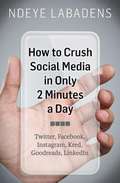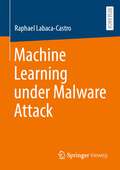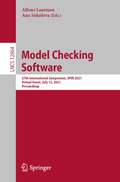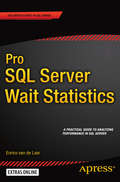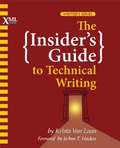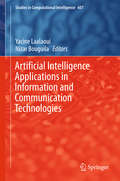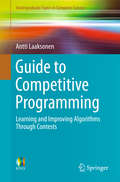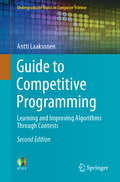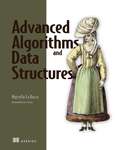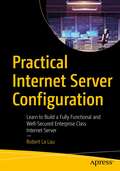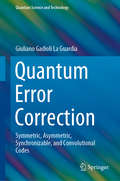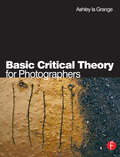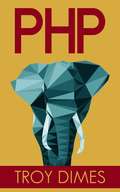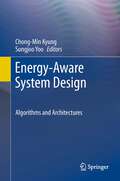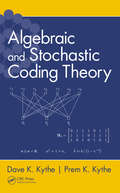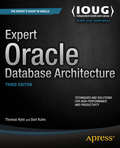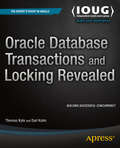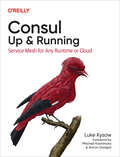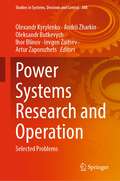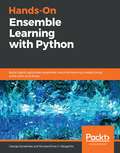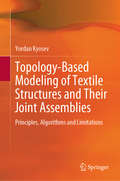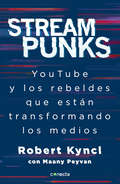- Table View
- List View
How To Crush Social Media In Only 2 Minutes A Day: Twitter, Facebook, Instagram, Kred, Goodreads, Linkedin
by Ndeye Labadens James Goonwrite. ComPrepare to Crush the Game of Social Media! This is a fun and powerful method to promote your business, book, or item. Why Do You Need to Crush Social Network? This book offers step- by- step instructions to build your social media presence with your platforms and /or blog. You'll have access to multiple resources to help increase your sales and your online presence. For example, do you know the best keywords to use? When is the most beneficial time to use Twitter? How do you change listings on Goodreads? You'll find answers to these questions and many more. Prepare to Crush the Social Media in Only 2 Minutes a Day is a must-have!
Machine Learning under Malware Attack
by Raphael Labaca CastroMachine learning has become key in supporting decision-making processes across a wide array of applications, ranging from autonomous vehicles to malware detection. However, while highly accurate, these algorithms have been shown to exhibit vulnerabilities, in which they could be deceived to return preferred predictions. Therefore, carefully crafted adversarial objects may impact the trust of machine learning systems compromising the reliability of their predictions, irrespective of the field in which they are deployed. The goal of this book is to improve the understanding of adversarial attacks, particularly in the malware context, and leverage the knowledge to explore defenses against adaptive adversaries. Furthermore, to study systemic weaknesses that can improve the resilience of machine learning models.
Model Checking Software: 27th International Symposium, SPIN 2021, Virtual Event, July 12, 2021, Proceedings (Lecture Notes in Computer Science #12864)
by Alfons Laarman Ana SokolovaThis book constitutes the refereed proceedings of the 27th International Symposium on Model Checking Software, SPIN 2021, held virtually in July 2021.The 3 full papers, 4 tool papers, and 1 case study presented together with 2 invited talks were carefully reviewed and selected from 20 submissions. Topics covered include formal verification techniques for automated analysis of software; formal analysis for modeling languages, such as UML/state charts; formal specification languages, temporal logic, design-by-contract; model checking, automated theorem proving, including SAT and SMT; verifying compilers; abstraction and symbolic execution techniques; and much more.
Pro SQL Server Wait Statistics
by Enrico LaarPro SQL Server Wait Statistics is a practical guide for analyzing and troubleshooting SQL Server performance using wait statistics. Whether you are new to wait statistics, or already familiar with them, this book will help you gain a deeper understanding of how wait statistics are generated and what they can mean for your SQL Server's performance. Besides the most common wait types, Pro SQL Server Wait Statistics goes further into the more complex and performance threatening wait types. The different wait types are categorized by their area of impact, and include CPU, IO, Lock, and many more different wait type categories. Filled with clear examples, Pro SQL Server Wait Statistics helps you gain practical knowledge of why and how specific wait times increase or decrease, and how they impact your SQL Server's performance. What you'll learn How wait Statistics are generated by SQL Server Script examples for analyzing and tuning wait statistics How to lower, or even eliminate, wait times that hurt performance How to query wait statistics information from Dynamic Management Views How to build reliable and solid wait statistics baselines from which to detect performance issues Who this book is for Pro SQL Server Wait Statistics is the perfect guide for SQL Server DBAs wanting to troubleshoot and optimize SQL Server database installations. The book is also of interest to database developers who are serious about developing highly-performant applications and reporting systems. Table of Contents Introduction Part I: Foundations of Wait Statistics Analysis 1. How Wait Statistics are Generated 2. Querying Wait Statistics 3. Building a Solid Baseline Part II: Wait Types 4. CPU Wait Types 5. I/O Wait Types 6. Backup Wait Types 7. Lock Wait Types 8. Latch Wait Types 9. High-Availability and Disaster Recovery Wait Types 10: Preemptive Wait Types 11: Background and Miscellaneous Wait Types 12. Chapter 12 13: Appendix A 14. Appendix B 15. Appendix C
Shaping the Digital Transformation of the Education Ecosystem in Europe: 31st EDEN Annual Conference 2022, Tallinn, Estonia, June 20–22, 2022, Proceedings (Communications in Computer and Information Science #1639)
by Mart Laanpere Terje VäljatagaThis book constitutes refereed proceedings of the 31st Annual Conference on European Distance and E-Learning Network, EDEN 2022, held in Tallinn, Estonia, from June 20–22, 2022. The 11 full papers and 2 short papers presented in this volume were carefully reviewed and selected from a total of 78 submissions. The papers in the volume are organised according to the following topical headings: higher education; teachers’ professional development; digital competencies; inclusive education
The Insider's Guide to Technical Writing
by Krista Van LaanEvery complex product needs to be explained to its users, and technical writers, also known as technical communicators, are the ones who do that job. A growing field, technical writing requires multiple skills, including an understanding of technology, writing ability, and great people skills. Whether you're thinking of becoming a technical writer, just starting out, or you've been working for a while and feel the need to take your skills to the next level, The Insider's Guide to Technical Writing can help you be a successful technical writer and build a satisfying career. Inside the Book Is This Job for Me? What does it take to be a technical writer? Building the Foundation: What skills and tools do you need to get started? The Best Laid Plans: How do you create a schedule that won't make you go crazy? How do you manage different development processes, including Agile methodologies? On the Job: What does it take to walk into a job and be productive right away? The Tech Writer Toolkit: How do you create style guides, indexes, templates and layouts? How do you manage localization and translation and all the other non-writing parts of the job? I Love My Job: How do you handle the ups and downs of being a technical writer? Appendixes: References to websites, books, and other resources to keep you learning. Index
Artificial Intelligence Applications in Information and Communication Technologies (Studies in Computational Intelligence #607)
by Yacine Laalaoui Nizar BouguilaThis book presents various recent applications of Artificial Intelligence in Information and Communication Technologies such as Search and Optimization methods, Machine Learning, Data Representation and Ontologies, and Multi-agent Systems. The main aim of this book is to help Information and Communication Technologies (ICT) practitioners in managing efficiently their platforms using AI tools and methods and to provide them with sufficient Artificial Intelligence background to deal with real-life problems.
Guide to Competitive Programming
by Antti LaaksonenThis invaluable textbook presents a comprehensive introduction to modern competitive programming. The text highlights how competitive programming has proven to be an excellent way to learn algorithms, by encouraging the design of algorithms that actually work, stimulating the improvement of programming and debugging skills, and reinforcing the type of thinking required to solve problems in a competitive setting. The book contains many "folklore" algorithm design tricks that are known by experienced competitive programmers, yet which have previously only been formally discussed in online forums and blog posts. Topics and features: reviews the features of the C++ programming language, and describes how to create efficient algorithms that can quickly process large data sets; discusses sorting algorithms and binary search, and examines a selection of data structures of the C++ standard library; introduces the algorithm design technique of dynamic programming, and investigates elementary graph algorithms; covers such advanced algorithm design topics as bit-parallelism and amortized analysis, and presents a focus on efficiently processing array range queries; surveys specialized algorithms for trees, and discusses the mathematical topics that are relevant in competitive programming; examines advanced graph techniques, geometric algorithms, and string techniques; describes a selection of more advanced topics, including square root algorithms and dynamic programming optimization. This easy-to-follow guide is an ideal reference for all students wishing to learn algorithms, and practice for programming contests. Knowledge of the basics of programming is assumed, but previous background in algorithm design or programming contests is not necessary. Due to the broad range of topics covered at various levels of difficulty, this book is suitable for both beginners and more experienced readers. <P><P><i>Advisory: Bookshare has learned that this book offers only partial accessibility. We have kept it in the collection because it is useful for some of our members. To explore further access options with us, please contact us through the Book Quality link on the right sidebar. Benetech is actively working on projects to improve accessibility issues such as these.</i>
Guide to Competitive Programming: Learning and Improving Algorithms Through Contests (Undergraduate Topics in Computer Science)
by Antti LaaksonenBuilding on what already is the most comprehensive introduction to competitive programming, this enhanced new textbook features new material on advanced topics, such as calculating Fourier transforms, finding minimum cost flows in graphs, and using automata in string problems. Critically, the text accessibly describes and shows how competitive programming is a proven method of implementing and testing algorithms, as well as developing computational thinking and improving both programming and debugging skills.Topics and features: introduces dynamic programming and other fundamental algorithm design techniques, and investigates a wide selection of graph algorithms; compatible with the IOI Syllabus, yet also covering more advanced topics, such as maximum flows, Nim theory, and suffix structures; surveys specialized algorithms for trees, and discusses the mathematical topics that are relevant in competitive programming; reviews the features of the C++ programming language, and describes how to create efficient algorithms that can quickly process large data sets; discusses sorting algorithms and binary search, and examines a selection of data structures of the C++ standard library; covers such advanced algorithm design topics as bit-parallelism and amortized analysis, and presents a focus on efficiently processing array range queries; describes a selection of more advanced topics, including square-root algorithms and dynamic programming optimization.Fully updated, expanded and easy to follow, this core textbook/guide is an ideal reference for all students needing to learn algorithms and to practice for programming contests. Knowledge of programming basics is assumed, but previous background in algorithm design or programming contests is not necessary. With its breadth of topics, examples and references, the book is eminently suitable for both beginners and more experienced readers alike.
Remote Sensing for Hydrocarbon Exploration (Springer Remote Sensing/Photogrammetry)
by Andreas LaakeThis book provides insights into the benefits of using remote sensing data from a geoscientist's perspective, by integrating the data with the understanding of Earth's surface and subsurface. In 3 sections, the book takes a detailed look at what data explorationists use when they explore for hydrocarbon resources, assess different terrain types for planning and hazards and extract present-day geologic analogs for subsurface geologic settings. The book presents the usage of remote sensing data in exploration in a structured way by detecting individual geologic features as building blocks for complex geologic systems. This concept enables readers to build their own workflows for the assessment of complex geologic systems using various combinations of remote sensing data. Section 1 introduces readers to the foundations of remote sensing for exploration, covers various methods of image processing and studies different digital elevation and bathymetry models. Section 2 presents the concept of geomorphology as a means to integrate surface and subsurface data. Different aspects of rendering in 2D and 3D are explained and used for the interpretation and extraction of geologic features that are used in exploration.Section 3 addresses remote sensing for hydrocarbon exploration in detail, from geophysical data acquisition to development and infrastructure planning. The organization of this chapter follows an exploration workflow from regional to local modeling studying basin and petroleum system modeling as well as logistics planning of seismic surveys and near-surface modeling. Aspects of field development and infrastructure planning comprise multi-temporal and dynamic modeling. The section closes with a structured approach to extracting geologic analogs from interpreted remote sensing data.The book will be of interest to professionals and students working in exploration for hydrocarbons and water resources, as well as geoscientists and engineers using remote sensing for infrastructure planning, hazard assessment and dynamic environmental studies.
Advanced Algorithms and Data Structures
by Marcello La RoccaAdvanced Algorithms and Data Structures introduces a collection of algorithms for complex programming challenges in data analysis, machine learning, and graph computing.Summary As a software engineer, you&’ll encounter countless programming challenges that initially seem confusing, difficult, or even impossible. Don&’t despair! Many of these &“new&” problems already have well-established solutions. Advanced Algorithms and Data Structures teaches you powerful approaches to a wide range of tricky coding challenges that you can adapt and apply to your own applications. Providing a balanced blend of classic, advanced, and new algorithms, this practical guide upgrades your programming toolbox with new perspectives and hands-on techniques. Purchase of the print book includes a free eBook in PDF, Kindle, and ePub formats from Manning Publications. About the technology Can you improve the speed and efficiency of your applications without investing in new hardware? Well, yes, you can: Innovations in algorithms and data structures have led to huge advances in application performance. Pick up this book to discover a collection of advanced algorithms that will make you a more effective developer. About the book Advanced Algorithms and Data Structures introduces a collection of algorithms for complex programming challenges in data analysis, machine learning, and graph computing. You&’ll discover cutting-edge approaches to a variety of tricky scenarios. You&’ll even learn to design your own data structures for projects that require a custom solution. What's inside Build on basic data structures you already know Profile your algorithms to speed up application Store and query strings efficiently Distribute clustering algorithms with MapReduce Solve logistics problems using graphs and optimization algorithms About the reader For intermediate programmers. About the author Marcello La Rocca is a research scientist and a full-stack engineer. His focus is on optimization algorithms, genetic algorithms, machine learning, and quantum computing. Table of Contents 1 Introducing data structures PART 1 IMPROVING OVER BASIC DATA STRUCTURES 2 Improving priority queues: d-way heaps 3 Treaps: Using randomization to balance binary search trees 4 Bloom filters: Reducing the memory for tracking content 5 Disjoint sets: Sub-linear time processing 6 Trie, radix trie: Efficient string search 7 Use case: LRU cache PART 2 MULTIDEMENSIONAL QUERIES 8 Nearest neighbors search 9 K-d trees: Multidimensional data indexing 10 Similarity Search Trees: Approximate nearest neighbors search for image retrieval 11 Applications of nearest neighbor search 12 Clustering 13 Parallel clustering: MapReduce and canopy clustering PART 3 PLANAR GRAPHS AND MINIMUM CROSSING NUMBER 14 An introduction to graphs: Finding paths of minimum distance 15 Graph embeddings and planarity: Drawing graphs with minimal edge intersections 16 Gradient descent: Optimization problems (not just) on graphs 17 Simulated annealing: Optimization beyond local minima 18 Genetic algorithms: Biologically inspired, fast-converging optimization
Practical Internet Server Configuration: Learn to Build a Fully Functional and Well-Secured Enterprise Class Internet Server
by Robert La LauLearn the skills to complete the full installation, configuration, and maintenance of an enterprise class internet server, no matter what Unix-like operating system you prefer. This book will rapidly guide you towards real system administration, with clear explanations along the way.After a chapter explaining the most important Unix basics, you will start with a vanilla server as delivered by a hosting provider and by the end of the book, you will have a fully functional and well-secured enterprise class internet server. You will also be equipped with the expertise needed to keep your server secured and up to date. All configuration examples are given for FreeBSD, Debian and CentOS, so you are free to choose your operating system. No single blueprint exists for an internet server, and an important part of the work of a system administrator consists of analyzing, interpreting and implementing specific wishes, demands and restrictions from different departments and viewpoints within an organization. Practical Internet Server Configuration provides the information you need to succeed as a sysadmin. What You'll Learn Configure DNS using Bind 9Set up Apache and NginxCustomize a mail server: IMAP (Dovecot) and SMTP (Postfix), spam filtering includedAuthenticate mail users using LDAPInstall and maintain MariaDB and PostgreSQL databasesPrepare SSL/TLS certificates for the encryption of web, mail and LDAP trafficSynchronize files, calendars and address books between devicesBuild a firewall: PF for FreeBSD and nftables for Linux Who This Book Is For This book can be used by aspiring and beginning system administrators who are working on personal servers, or more experienced system administrators who may know Unix well but need a reference book for the more specialized work that falls outside the daily routine. Basic understanding of Unix and working on the command line is necessary.
Quantum Error Correction: Symmetric, Asymmetric, Synchronizable, and Convolutional Codes (Quantum Science and Technology)
by Giuliano Gadioli La GuardiaThis text presents an algebraic approach to the construction of several important families of quantum codes derived from classical codes by applying the well-known Calderbank-Shor-Steane (CSS), Hermitian, and Steane enlargement constructions to certain classes of classical codes. In addition, the book presents families of asymmetric quantum codes with good parameters and provides a detailed description of the procedures adopted to construct families of asymmetric quantum convolutional codes.Featuring accessible language and clear explanations, the book is suitable for use in advanced undergraduate and graduate courses as well as for self-guided study and reference. It provides an expert introduction to algebraic techniques of code construction and, because all of the constructions are performed algebraically, it enables the reader to construct families of codes, rather than only codes with specific parameters. The text offers an abundance of worked examples, exercises, and open-ended problems to motivate the reader to further investigate this rich area of inquiry. End-of-chapter summaries and a glossary of key terms allow for easy review and reference.
Basic Critical Theory for Photographers
by Ashley la GrangeBasic Critical Theory for Photographers generates discussion, thought and practical assignments around key debates in photography. Ashley la Grange avoids the trap of an elitist and purely academic approach to critical theory, taking a dual theoretical and practical approach when considering the issues. Key critical theory texts (such as Sontag's 'On Photography' and Barthes' 'Camera Lucida') are clarified and shortened. La Grange avoids editorilising, letting the arguments develop as the writers had intended; it is the assignments which call into question each writer's approach and promote debate.This is the ideal book if you want to understand key debates in photography and have a ready-made structure within which to discuss and explore these fascinating issues. It is accessible to students, from high school to university level, but will also be of interest to the general reader and to those photographers whose training and work is concerned with the practical aspects of photography.Also includes invaluable glossary of terms and a substantial index that incorporates the classic texts, helping you to navigate your way through these un-indexed works. The book also contains useful information on photo-mechanical processes, explaining how a photograph can appear very differently, and as a result be interpreted in a range of ways, in a variety of books.
Merch Domination: The Ultimate Guide to Merch by Amazon
by Neil LMerch by Amazon has been the premier place for print on demand t-shirt designs since late 2015. This platform is easy to learn but hard to master. When you get the hang out if, Merch by Amazon can easily replace your full time income and could potentially lead to a nice six figure a year side income if you practice the lessons laid out in this Amazon Merch book. Learn from those who have done it before and continue to be some of the top power sellers on Merch. If you are interested in setting up a profitable Merch by Amazon t-shirt business, then you need to read the entire Merch Domination book. Within the hundreds of pages you will learn how to sell your custom artwork and novelty designs on Amazon with print on demand t-shirts. Take advantage of the biggest ecommerce retailer the world has ever known
PHP
by Caroline L. Troy DimesEl Preprocesador Hipertexto, comúnmente llamado PHP, es uno de los lenguajes de programación cliente-servidor de códigos abiertos más ampliamente usados. Sitios web famosos incluyendo Facebook, Yahoo, Friendster, WorldPress y Flickr son arrancados por PHP. Este libro proporciona una breve introducción de programación en PHP. En éste, a usted se le enseñarán conceptos importantes de PHP, comenzando con lo básico y moviéndose a un PHP orientado a objetos más avanzados.
Energy-Aware System Design
by Chong-Min Kyung Sungjoo YooPower consumption becomes the most important design goal in a wide range of electronic systems. There are two driving forces towards this trend: continuing device scaling and ever increasing demand of higher computing power. First, device scaling continues to satisfy Moore's law via a conventional way of scaling (More Moore) and a new way of exploiting the vertical integration (More than Moore). Second, mobile and IT convergence requires more computing power on the silicon chip than ever. Cell phones are now evolving towards mobile PC. PCs and data centers are becoming commodities in house and a must in industry. Both supply enabled by device scaling and demand triggered by the convergence trend realize more computation on chip (via multi-core, integration of diverse functionalities on mobile SoCs, etc.) and finally more power consumption incurring power-related issues and constraints. Energy-Aware System Design: Algorithms and Architectures provides state-of-the-art ideas for low power design methods from circuit, architecture to software level and offers design case studies in three fast growing areas of mobile storage, biomedical and security. Important topics and features: - Describes very recent advanced issues and methods for energy-aware design at each design level from circuit and architecture to algorithm level, and also covering important blocks including low power main memory subsystem and on-chip network at architecture level - Explains efficient power conversion and delivery which is becoming important as heterogeneous power sources are adopted for digital and non-digital parts - Investigates 3D die stacking emphasizing temperature awareness for better perspective on energy efficiency - Presents three practical energy-aware design case studies; novel storage device (e.g., solid state disk), biomedical electronics (e.g., cochlear and retina implants), and wireless surveillance camera systems. Researchers and engineers in the field of hardware and software design will find this book an excellent starting point to catch up with the state-of-the-art ideas of low power design.
Algebraic and Stochastic Coding Theory
by Dave K. Kythe Prem K. KytheUsing a simple yet rigorous approach, Algebraic and Stochastic Coding Theory makes the subject of coding theory easy to understand for readers with a thorough knowledge of digital arithmetic, Boolean and modern algebra, and probability theory. It explains the underlying principles of coding theory and offers a clear, detailed description of each code. More advanced readers will appreciate its coverage of recent developments in coding theory and stochastic processes. After a brief review of coding history and Boolean algebra, the book introduces linear codes, including Hamming and Golay codes. It then examines codes based on the Galois field theory as well as their application in BCH and especially the Reed–Solomon codes that have been used for error correction of data transmissions in space missions. The major outlook in coding theory seems to be geared toward stochastic processes, and this book takes a bold step in this direction. As research focuses on error correction and recovery of erasures, the book discusses belief propagation and distributions. It examines the low-density parity-check and erasure codes that have opened up new approaches to improve wide-area network data transmission. It also describes modern codes, such as the Luby transform and Raptor codes, that are enabling new directions in high-speed transmission of very large data to multiple users. This robust, self-contained text fully explains coding problems, illustrating them with more than 200 examples. Combining theory and computational techniques, it will appeal not only to students but also to industry professionals, researchers, and academics in areas such as coding theory and signal and image processing.
Expert Oracle Database Architecture
by Thomas Kyte Darl KuhnNow in its third edition, this best-selling book continues to bring you some of the best thinking on how to apply Oracle Database to produce scalable applications that perform well and deliver correct results. Tom Kyte and Darl Kuhn share a simple philosophy: "you can treat Oracle as a black box and just stick data into it, or you can understand how it works and exploit it as a powerful computing environment. " If you choose the latter, then you'll find that there are few information management problems that you cannot solve quickly and elegantly. This fully revised third edition covers the developments up to Oracle Database 12c. Significant new content is included surrounding Oracle's new cloud feature set, and especially the use of pluggable databases. Each feature is taught in a proof-by-example manner, not only discussing what it is, but also how it works, how to implement software using it, and the common pitfalls associated with it. Don't treat Oracle Database as a black-box. Get this book. Get under the hood. Turbo-charge your career. Revised to cover Oracle Database 12c Proof-by-example approach: Let the evidence be your guide Dives deeply into Oracle Database's most powerful features What you'll learn Develop an evidence-based approach to problem solving Manage transactions in highly concurrent environments Speed access to data through table and index design Manage files and memory structures for performance and reliability Scale up through partitioning and parallel processing Load and unload data to interface with external systems Who this book is for Expert Oracle Database Architecture is aimed at Oracle Database administrators, at PL/SQL and Java developers writing code to be deployed inside the database, and at developers of external applications who use Oracle Database as a data store. It is the go-to book for those wishing to create efficient and scalable applications. Table of Contents Developing Successful Oracle Applications Architecture Overview Files Memory Structures Oracle Processes Locking and Latching Concurrency and Multi-versioning Transactions Redo and Undo Database Tables Indexes Datatypes Partitioning Parallel Execution Data Loading and Unloading
Oracle Database Transactions and Locking Revealed
by Thomas Kyte Darl KuhnOracle Database Transactions and Locking Revealed provides much-needed information for building scalable, high-concurrency applications and deploy them against the Oracle Database. Read this short, 150-page book that is adapted from Expert Oracle Database Architecture to gain a solid and accurate understanding of how locking and concurrency are dealt with by Oracle Database. Also learn how the Oracle Database architecture accommodates user transactions, and how you can write code to mesh with how Oracle Database is designed to operate. Good transaction design is an important facet of highly-concurrent applications that are run by hundreds, even thousands of users who are all executing transactions at the same time. Transaction design in turn relies upon a good understanding of how the underlying database platform manages of the locking of resources so as to prevent access conflicts and data loss that might otherwise result from concurrent access to data in the database. Oracle Database Transactions and Locking Revealed covers in detail the various lock types, and also different locking schemes such as pessimistic and optimistic locking. Then you'll learn about transaction isolation and multiversion concurrency, and how the various lock types support Oracle Database's transactional features. You'll learn some good tips for transaction design, as well as some bad practices and habits to avoid. Coverage is also given to redo and undo, and their role in concurrency. This is an important book that anyone developing highly-concurrent applications will want to have handy on their shelf. What you'll learn Understand locks and their implication for concurrent applications Manage transaction isolation to meet business needs while not impeding concurrency Design effective transactions and choose the correct atomicity level for your needs Take advantage of features such as deferrable constraints and autonomous transactions Build multi-database applications with needed atomicity through distributed transactions Investigate and troubleshoot redo and undo problems that can impede concurrency Who this book is for Oracle Database Transactions and Locking Revealed is the definitive book on transactions and locking for Oracle Database developers and architects who are developing highly-concurrent applications. Readers should already have good understanding of SQL and PL/SQL. Experience in application development is also beneficial. Table of Contents 1. Building for Concurrency 2. Locking and Issues 3. Lock Types 4. Concurrency and Multiversioning 5. Transactions 6. Redo and Undo 7. Investigating Undo 8. Investigating Undo
Consul: Service Mesh For Any Runtime Or Cloud
by Luke KysowWith the advent of microservices, Kubernetes, public cloud, and hybrid computing, SREs and system engineers are facing more complexity than ever before. To tackle this problem, you need a unified control plane to manage the networking among your applications running on these distinct platforms. This definitive guide shows you how to automate networking for simple and secure application delivery with Consul. Author Luke Kysow, Consul engineer at HashiCorp, demonstrates how this service mesh solution provides a software-driven approach to security, observability, and traffic management. Once you learn how to implement zero-trust networking by deploying Consul on multiple platforms, you'll be able to take control of application traffic, prevent outages, view metrics, integrate with legacy systems, and more. Dive into the characteristics of service meshes, zero-trust networking, and traffic-shaping patternsDeploy Consul on multiple platforms, including Kubernetes and virtual machinesLearn how to secure, monitor, and manage your application traffic with ConsulUse this guide to deploy and operate applications as a system administrator, DevOps engineer, or developer
Power Systems Research and Operation: Selected Problems (Studies in Systems, Decision and Control #388)
by Olexandr Kyrylenko Andrii Zharkin Oleksandr Butkevych Ihor Blinov Ievgen Zaitsev Artur ZaporozhetsThis book examines the problems of power systems in fields related to optimization of operating modes of electric power facilities and their control systems, information and measuring systems and metrological support in the electric power industry, ensuring the functioning of the electric power system in the conditions of a competitive market of the electric power. The book is devoted to modern problems ensuring operational reliability and safety of objects integrated power system of Ukraine. It is complex task, solution of which is related to optimization of operating modes of electric power facilities and their control systems, creating diagnostic systems for the electric power industry, ensuring the functioning of the electric power system in the conditions of a competitive market of the electric power. The presented research results in book allow increasing the reliability and efficiency of operation of energy facilities and ensuring the stability of power systems, the introduction of effective methods and tools for forecasting electricity supply, optimize power systems, suggest road map to integrate electricity markets taking into account network constraints in modern conditions of electricity markets. The book includes eight chapters. A book is for researchers, engineers, as well as lecturers and postgraduates of higher education institutions dealing with problems of operation, control, diagnosis and monitoring of integrated power system, power equipment and other.
Hands-On Ensemble Learning with Python: Build highly optimized ensemble machine learning models using scikit-learn and Keras
by George Kyriakides Konstantinos G. MargaritisCombine popular machine learning techniques to create ensemble models using Python Key Features Implement ensemble models using algorithms such as random forests and AdaBoost Apply boosting, bagging, and stacking ensemble methods to improve the prediction accuracy of your model Explore real-world data sets and practical examples coded in scikit-learn and Keras Book Description Ensembling is a technique of combining two or more similar or dissimilar machine learning algorithms to create a model that delivers superior predictive power. This book will demonstrate how you can use a variety of weak algorithms to make a strong predictive model. With its hands-on approach, you'll not only get up to speed on the basic theory but also the application of various ensemble learning techniques. Using examples and real-world datasets, you'll be able to produce better machine learning models to solve supervised learning problems such as classification and regression. Furthermore, you'll go on to leverage ensemble learning techniques such as clustering to produce unsupervised machine learning models. As you progress, the chapters will cover different machine learning algorithms that are widely used in the practical world to make predictions and classifications. You'll even get to grips with the use of Python libraries such as scikit-learn and Keras for implementing different ensemble models. By the end of this book, you will be well-versed in ensemble learning, and have the skills you need to understand which ensemble method is required for which problem, and successfully implement them in real-world scenarios. What you will learn Implement ensemble methods to generate models with high accuracy Overcome challenges such as bias and variance Explore machine learning algorithms to evaluate model performance Understand how to construct, evaluate, and apply ensemble models Analyze tweets in real time using Twitter's streaming API Use Keras to build an ensemble of neural networks for the MovieLens dataset Who this book is for This book is for data analysts, data scientists, machine learning engineers and other professionals who are looking to generate advanced models using ensemble techniques. An understanding of Python code and basic knowledge of statistics is required to make the most out of this book.
Topology-Based Modeling of Textile Structures and Their Joint Assemblies: Principles, Algorithms And Limitations
by Yordan KyosevThis book presents the textile-, mathematical and mechanical background for the modelling of fiber based structures such as yarns, braided and knitted textiles. The hierarchical scales of these textiles and the structural elements at the different levels are analysed and the methods for their modelling are presented. The author reports about problems, methods and algorithms and possible solutions from his twenty year experience in the modelling and software development of CAD for textiles.
Streampunks: Youtube y los rebeldes que estan transformando los medios
by Robert Kyncl<P>En los últimos diez años, la plataforma de videos por internet YouTube ha cambiado los medios y el entretenimiento tan profundamente como lo hicieron la invención del cine, la radio y la televisión. <P>Streampunks es una mirada a esta empresa advenediza que examina cómo ha evolucionado YouTube y hacia dónde va. <P>Basándose en relatos de las estrellas más influyentes de YouTube (Streampunks como Tyler Oakley, Lilly Singh y Casey Neistat) y los negociadores que promueven el futuro del entretenimiento (como Scooter Braun y Shane Smith), Robert Kyncl utiliza sus experiencias en tres de las compañías de medios más innovadoras, HBO, Netflix y Youtube, para contar la historia del streaming y de este monstruo moderno de la cultura pop. <P>En colaboración con Maany Peyvan (escritor de contenido de Google), Kyncl explica cómo se dictan las nuevas reglas del entretenimiento y cómo y por qué el panorama de los medios está cambiando radicalmente.
